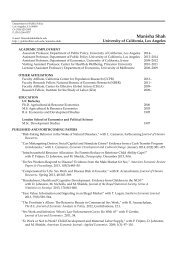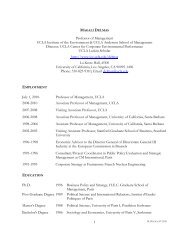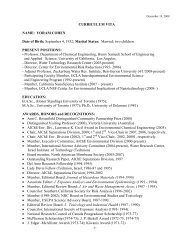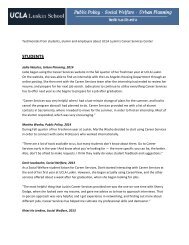Making a Market Executive Summary.pdf - UCLA Luskin School of ...
Making a Market Executive Summary.pdf - UCLA Luskin School of ...
Making a Market Executive Summary.pdf - UCLA Luskin School of ...
Create successful ePaper yourself
Turn your PDF publications into a flip-book with our unique Google optimized e-Paper software.
What policies would most effectively promote solar in<br />
multi-family housing?<br />
From a policy perspective, the fundamental question is: How can the city effectively<br />
promote the development <strong>of</strong> solar capacity on multi-family ro<strong>of</strong>tops in Los Angeles?<br />
The question has been explored in depth in <strong>UCLA</strong>’s previous studies on the solar<br />
FiT, primarily examining the ways in which building owners can be appropriately<br />
incentivized to invest in solar panels, thus creating a new, renewable source <strong>of</strong> energy,<br />
while also ensuring that city ratepayers are protected from undue rate increases.<br />
In looking at multi-family housing, the key factors are the installation cost <strong>of</strong> solar<br />
panels; the rate paid to the building owner per kilowatt-hour generated; and the tax<br />
incentives available to subsidize the installation <strong>of</strong> panels. It is important to note that<br />
there are three distinct sectors within the multi-family category. Each has its own<br />
unique scenario, in terms <strong>of</strong> incentives and tax advantages, and therefore each<br />
requires different policy options. The three sectors are: small residential apartments<br />
(4 units or fewer), commercial rentals (5+ units) and condos.<br />
Fortunately, in the case <strong>of</strong> commercial rentals, which tend to have the most available<br />
ro<strong>of</strong>top space, there are generous incentives made available by the federal<br />
government. For apartments <strong>of</strong> 5 or more units, both an investment tax credit and<br />
standard depreciation would apply. These factors significantly defray the cost <strong>of</strong><br />
investment, and thus lower the rate that must be paid by the utility for energy.<br />
FiT (Feed-in Tariff); ITC (Investment Tax Credit); MACR<br />
(Modified Accelerated Cost Recovery System) depreciation credits<br />
12









